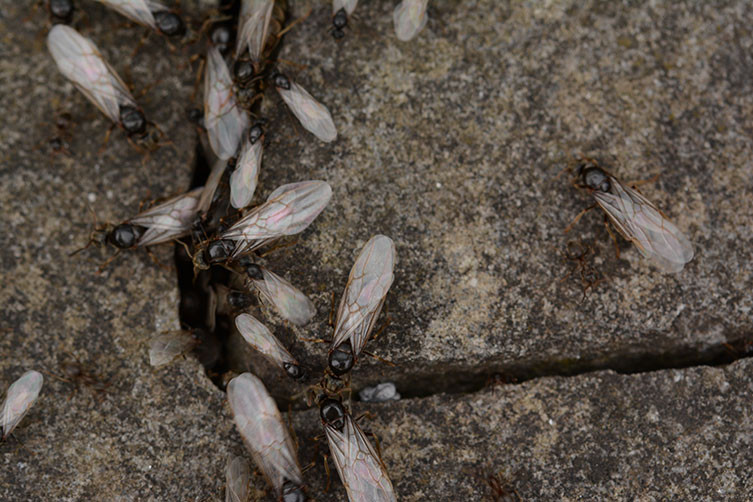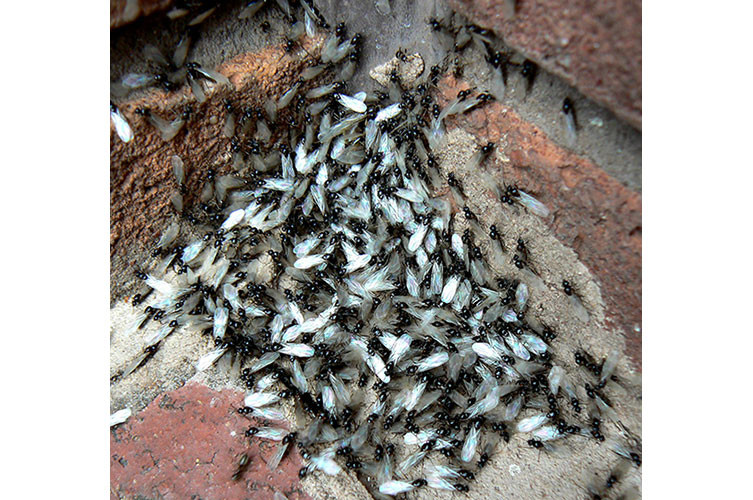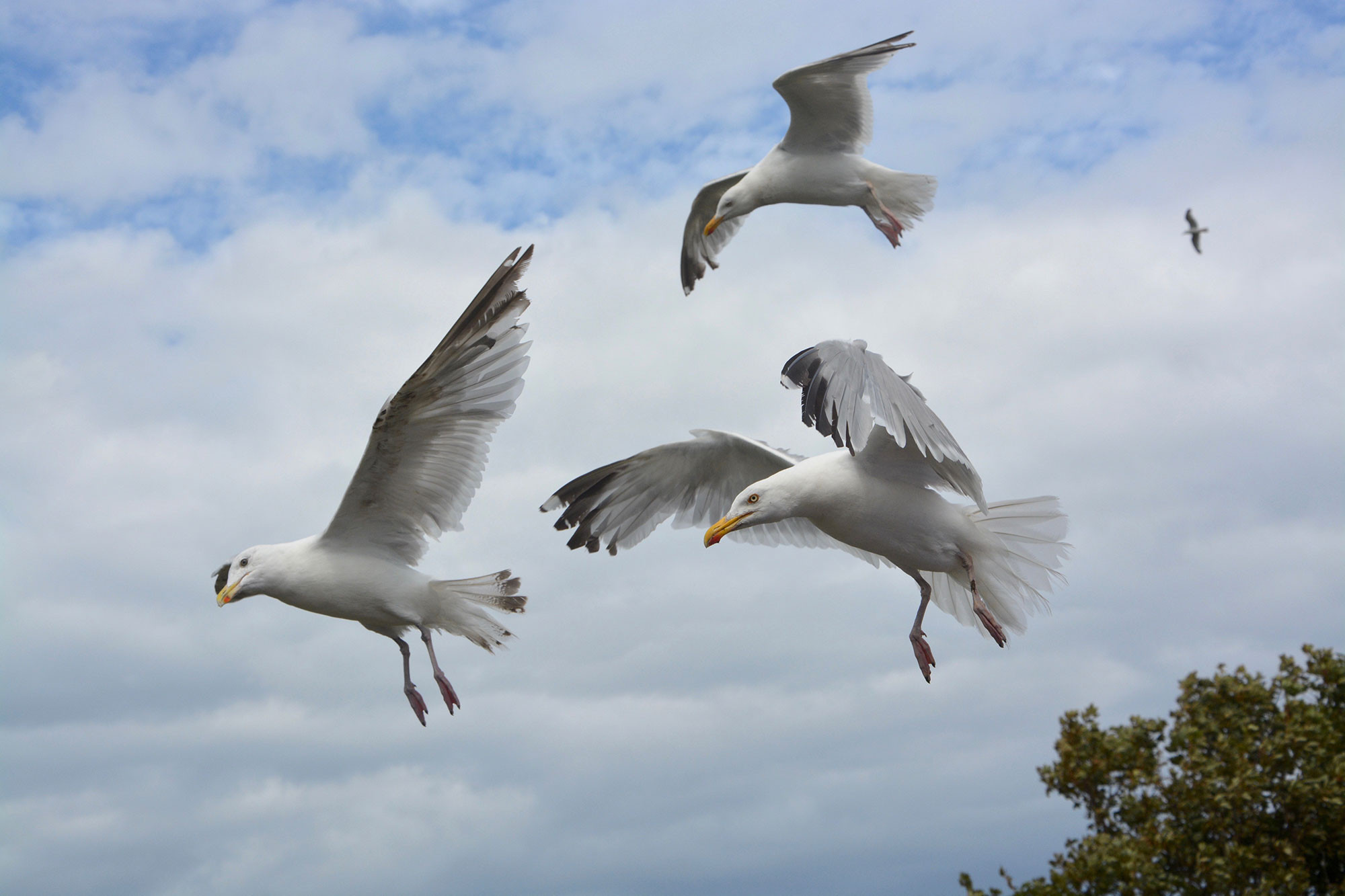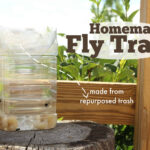Each year, often during the warmer months, many of us are caught by surprise when swarms of winged ants suddenly appear. One moment everything seems normal, and the next, the ground is alive with crawling insects, and the air buzzes with their flight. This phenomenon, often dubbed ‘flying ant day’, leads many to wonder: where do these flying ants come from, and why do they appear all at once?
To understand this, we need to delve into the fascinating life cycle of ants and explore the event known as the nuptial flight. The flying ants we observe are scientifically called alates, and in the UK, especially in urban settings, they are predominantly the sexually mature queens and males of the black garden ant, Lasius niger. The larger of these winged ants are the queens, noticeable for their size, reaching up to 15mm in length.
 Winged ants on a buildingAlt text: Black garden ants alates, including larger queens and smaller males, congregate on the side of a building during their nuptial flight period.
Winged ants on a buildingAlt text: Black garden ants alates, including larger queens and smaller males, congregate on the side of a building during their nuptial flight period.
The emergence of flying ants is a seasonal event, primarily occurring in July and August, typically during periods of hot and humid weather. While often referred to as ‘flying ant day’, research indicates that it’s more accurately a ‘flying ant season’. These winged ants don’t all emerge on a single day nationwide but rather over several weeks, with peaks of activity lasting a few days at a time. Local weather conditions play a crucial role in synchronizing swarming activity, which explains why flying ants might appear at different times in different locations. Interestingly, flying ants are often seen earlier in urban areas compared to rural ones, likely due to the urban heat island effect, where cities tend to retain more warmth.
 Winged ants about to flyAlt text: Alates, or winged ants, emerge from their nest entrances on a pavement, preparing for their nuptial flight during a warm summer spell.
Winged ants about to flyAlt text: Alates, or winged ants, emerge from their nest entrances on a pavement, preparing for their nuptial flight during a warm summer spell.
So, where do flying ants actually originate? Before their dramatic aerial display, these ants live in established colonies, typically nesting underground. Black garden ants favor dry soil for their nests, commonly found in gardens, lawns, under paving stones, and patios. They thrive in sunny, dry areas including gardens, pavements, brownfield sites, heathland, grassland, and coastal regions. In the weeks leading up to the swarming event, you might notice small mounds of soil appearing near nest entrances, indicating the colony’s preparation for the alates’ departure.
 Exposed ant nestAlt text: An exposed Lasius niger ant nest shows worker ants and pupae, revealing the underground origin of flying ants in a typical garden setting.
Exposed ant nestAlt text: An exposed Lasius niger ant nest shows worker ants and pupae, revealing the underground origin of flying ants in a typical garden setting.
Ant colonies operate under a caste system. The queen’s primary role is to lay eggs, while worker ants, who are female but sterile, handle nest maintenance, brood care, and foraging for food. Most eggs develop into workers. However, when a colony reaches maturity and resources are plentiful, the queen starts producing virgin queens (princesses) and males (drones). These are the flying ants, or alates, that we see during the swarm. When these winged males and virgin queens emerge from their nests, they disperse widely to maximize mating opportunities with individuals from different colonies, reducing the risk of inbreeding.
The reason ants develop wings and take to the air is for their nuptial flight, a critical phase in their reproductive cycle. An ant colony has limited space for expansion, and at some point, new queens must establish their own colonies. To do this, they need to mate with males from other colonies and find a new location to build their nests. Growing wings and flying is their way to achieve this dispersal and mating. Therefore, flying ants are not interested in humans or picnics; they are solely focused on finding a mate to start the next generation. Often, the larger winged queens and smaller winged males can be observed flying together, a phenomenon known as the nuptial flight, where mating occurs in the air or shortly after landing.
 Lots of winged ants in a corner between bricksAlt text: A large congregation of winged ants in a corner between bricks illustrates the sheer numbers involved in a flying ant swarm, increasing mating success.
Lots of winged ants in a corner between bricksAlt text: A large congregation of winged ants in a corner between bricks illustrates the sheer numbers involved in a flying ant swarm, increasing mating success.
The mass emergence, or swarming, of flying ants serves several purposes. Firstly, it provides protection from predators. The sheer volume of ants overwhelms predators, making it more likely that some individuals will survive to mate. There is indeed safety in numbers. Secondly, swarming increases the chances of successful reproduction. With a large number of potential mates in close proximity, ants are more likely to find a partner quickly. During this brief mating period, a queen typically mates with multiple males, ensuring a sufficient supply of sperm for her lifetime of egg-laying.
Following the nuptial flight, the males’ role is complete, and they typically die within a day or two. The mated queens, on the other hand, shed their wings by chewing them off and begin searching for suitable nesting sites to establish new colonies. This is why you might see larger wingless ants walking around after a ‘flying ant day’ and discarded wings scattered on pavements.
Alt text: A Lasius niger queen ant that has shed her wings after mating, now ready to establish a new colony and continue the ant life cycle.
The ants we commonly see throughout the rest of the year are the female worker ants, responsible for foraging and maintaining the colony. Once a queen finds a suitable location, she digs an underground chamber, lays her first eggs, and raises the initial brood to adulthood without eating, relying on her stored energy. She will not eat again until her first generation of worker daughters are ready to forage for her. The sperm stored from her nuptial flight enables her to lay fertilized eggs for years, often leading to colonies that number in the thousands, sometimes exceeding 20,000 workers.
Male flying ants have a very short lifespan, existing primarily to mate. They develop from unfertilized eggs and live for only about a week in total, with just a day or two after the nuptial flight. Queen ants, however, can live for many years, with black garden ant queens potentially living up to 15 years, and in some cases, even longer in captivity. However, their time as winged or flying ants is just a brief period at the start of their long reproductive lives.
Despite sometimes being seen as a nuisance, flying ants play beneficial roles in the ecosystem. Their tunneling activities help improve soil aeration and quality. Moreover, the swarming events provide a significant food source for various bird species. Swifts and gulls are frequently observed feeding frenziedly on swarming ants.
 Three flying seagullsAlt text: Seagulls in flight during a flying ant day, illustrating how swarming ants become a plentiful food source for birds and other wildlife.
Three flying seagullsAlt text: Seagulls in flight during a flying ant day, illustrating how swarming ants become a plentiful food source for birds and other wildlife.
Black garden ants, along with cornfield ants, also play a crucial role in the survival of the silver-studded blue butterfly, a declining species in many areas. These ants and butterflies have a mutually beneficial relationship. The ants protect the butterfly caterpillars from predators, and in return, they feed on secretions produced by the caterpillars.
Alt text: Lasius ants tending to a Plebejus argus caterpillar, highlighting the symbiotic relationship between ants and the silver-studded blue butterfly.
Ants, belonging to the Hymenoptera insect group alongside bees and wasps, are diverse in the UK, with around 60 species. While black garden ants are the most commonly observed flying ants, other species, such as red ants (Myrmica rubra), also undertake nuptial flights. Surveys have shown that black garden ants constitute the vast majority of observed flying ants, but depending on the habitat, different species may be more prevalent. For example, wood ants might be seen in woodland areas. Crucially, all ant species require favorable weather conditions – warm, still, and humid – to initiate their nuptial flights, although the specific weather triggers vary among species, leading to variations in their swarming times.
Alt text: A winged Myrmica rubra ant, commonly known as a red ant, demonstrating that black garden ants are not the only flying ant species in Britain.
In conclusion, flying ants come from established ant colonies where, under the right environmental conditions, mature colonies produce winged queens and males for reproduction. These alates emerge en masse for their nuptial flight, a spectacular natural event crucial for ant colony propagation and broader ecosystem health. While they might be a temporary annoyance, understanding where flying ants come from and their ecological role reveals them to be a fascinating and beneficial part of our natural world.

